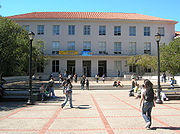
Dwinelle Hall
Encyclopedia

University of California, Berkeley
The University of California, Berkeley , is a teaching and research university established in 1868 and located in Berkeley, California, USA...
campus. It was completed in 1952, and is named after John W. Dwinelle, who was the State Assemblyman responsible for the "Organic Act
Organic Act
An Organic Act, in United States law, is an Act of the United States Congress that establishes a territory of the United States or an agency to manage certain federal lands. The first such act was the Northwest Ordinance, enacted by the Congress of the Confederation in 1787 in order to create the...
" that established the University of California in 1868. He was a member of the first Board of Regents
Board of Regents
In the United States, a board often governs public institutions of higher education, which include both state universities and community colleges. In each US state, such boards may govern either the state university system, individual colleges and universities, or both. In general they operate as...
.
Although many myths surround the odd construction of the building, Dwinelle Hall was designed by Ernest E. Weihe, Edward L. Frick, and Lawrence A. Kruse, with Eckbo Royston & Williams, landscape artists. Construction was completed in 1953, with expansion completed in 1998. The southern block of Dwinelle Hall contains three levels of classrooms as well as four lecture halls, and the northern block houses seven stories of faculty and department offices.http://dwinelle.berkeley.edu/MAPS/MapsDirectoriesMenu.html While the northern office block of Dwinelle is often referred to as the "Dwinelle Annex," it should not be confused with the Dwinelle Annex, which is a wooden building located to the west of Dwinelle Hall.http://dwinelle.berkeley.edu/MAPS/MapsDirectoriesMenu.html
The Dwinelle Annex was designed by John Galen Howard
John Galen Howard
John Galen Howard was an American architect.He is best known for his work as the supervising architect of the Master Plan for the University of California, Berkeley campus, and for founding the University of California's architecture program...
and built in 1920. From 1920-33 it was used for Military Science, and from 1933-58 it was used for Music. During these periods of use, it was called the Military Sciences Building and the Music Building. Some remodeling was done in 1933 to accommodate the music department, and in 1949 it was enlarged to include a music library. Dramatic Arts and Comparative Literature moved into the building in 1958. More recently, the College Writing Program occupied the top floor. The annex is currently occupied by the Department of Theater, Dance, and Performance Studies
Performance Studies
Performance studies have been growing as an academic field since the 1960s. Performance studies believe in the social act of Doing as it takes performance itself as the object of inquiry.The process of defining it becomes a practice in performance studies itself...
.
Construction
The location and design of Dwinelle Hall was chosen to allow easier access for the expanded student body after World War II, as well as for faculty after the center of campus shifted southward towards Sather Gate. Dwinelle's odd shape was not created on a whim or by accident. The north wing and office block are aligned with Berkeley's older buildings like California Hall, Wheeler Hall, and Doe Library, while the southern wing is aligned with the (at the time) newer section of campus containing Sproul Hall as well as the city grid to the south.Norman Jensen oversaw the construction of Dwinelle Hall, and the same firm that constructed San Francisco's City Hall, Arthur Brown, Jr., selected the company of Weihe, Frick and Kruse to construct the building. The construction site was initially intended for two separate buildings, and the annex was to be built with lower ceilings, and simple heating and ventilation systems, because it was designed to house offices rather than classrooms. Reinforced concrete
Reinforced concrete
Reinforced concrete is concrete in which reinforcement bars , reinforcement grids, plates or fibers have been incorporated to strengthen the concrete in tension. It was invented by French gardener Joseph Monier in 1849 and patented in 1867. The term Ferro Concrete refers only to concrete that is...
was used in construction because "granite was no longer a viable facing option."
The Dwinelle Expansion Project was begun in 1996 and was completed in 1998. The project included the addition of two new floors to the office block, cost $10 million, expanded the building about 20%, and required the temporary removal of the roof.
Dwinelle is frequently referred to as the "Freshman Maze" because of its confusing architecture. Soon after the building's construction, according to author William Rodarmor, students would "enter Dwinelle in their freshman year and emerge, blinking in the sunshine, just in time for graduation." As it was constructed on a slope, there are separate entrances to the building that connect directly to the first, second, third, and fourth floors. On every floor, there is a hallway or staircase to connect the main part of the building to the annex, and it is possible, positioned in certain areas of the building, to view five staircases, two elevators, and four hallways.
Interesting facts
Close examination will reveal that the "A" in "Hall" as seen on the sign to the right of the west entrance to the classroom wing is slightly taller than the other letters.It is possible to walk from level F to level G without ascending or descending.
External links
- Archived copy of an Official Dwinelle Website
- Information about all UC Berkeley campus buildings

